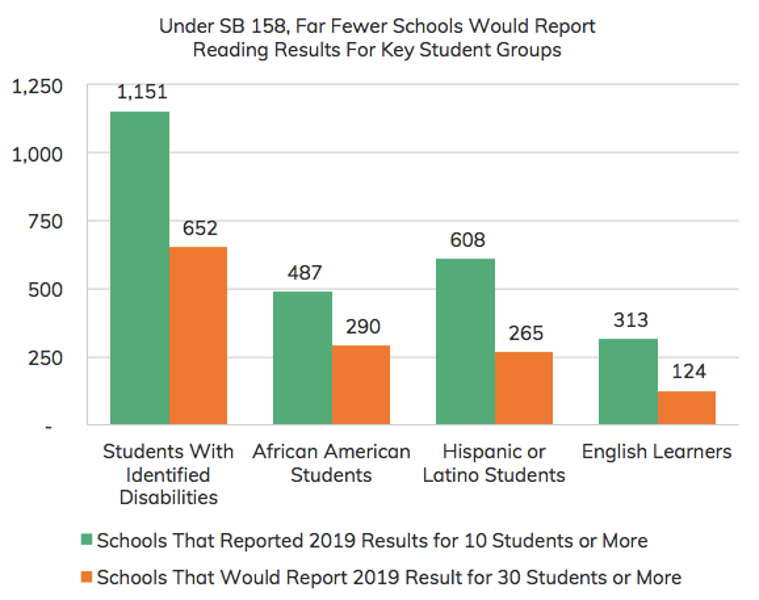Here’s our starting take on the major accountability changes in Senate Bill 158, filed last week by Sen. David Givens. We’ve also developed a 2-page overview of how the bill compares to Kentucky’s current law and practice for readers who want to take a closer look.
There are strengths and necessary components of SB 158, such as adjusting the minimum high school graduation requirements and changing requirements for local school board charter school authorizing training. It also re-defines TSI and ATSI, which was called for by the U.S. Department of Education last year. However, in our review of the bill we have identified some factors, outlined below, that merit further consideration and discussion as to how they will impact student outcomes, various student groups, and the newly designed accountability system, which has just been in use since October. We believe that changing the system year after year will cause policy churn fatigue that will lessen the impact of these important accountability measures. It is imperative that Kentucky’s accountability model has staying power and that it vigorously promotes excellence with equity.
Concern 1: Reducing Data on Student Groups
Kentucky currently reports results if a group has 10 or more students at school, but SB 158 would limit pubic reporting to groups of 30 or more. Here’s a quick chart of how big a change we’d expect in reporting just on reading results:

Math results would be similar, and the reductions would be even greater for graduation data and for science, social studies, and writing performance. Communities need the full information provided now to start conversations and mobilization efforts that can build excellence with equity, and this change would weaken those opportunities. We hope this element of SB 158 will not become law.
Concern 2: Rating Schools on Percentiles, Rather than Goals.
Late last summer, Kentucky educators decided on the cut points Kentucky now uses to convert numerical indicator scores to ratings from very low to very high. Under SB 158, those cut points would change again, this time to use norm-referenced percentiles and distribution data. For example, that could mean that all schools in the top 20% on the proficiency indicator would count as be very high. That could be true even if some schools in the top 20% only earned 60 points on the 125-point scale for that indicator. The key idea is that ratings would use on the “curve” of current performance and pretty much guarantee that some top ratings will be handed out in every category.
By focusing on the distribution of current results, this part of SB 158 would undermine Kentucky’s commitment to moving student results to much higher levels. Kentucky has set ambitious goals for changing our student outcomes, and our school rating should provide clear information on where we stand in relation to those goals. A percentile-based approach will not do that, making this change a major concern about the current bill.
Concern 3: Weakening Attention and Support For CSI Schools
For schools identified for CSI (comprehensive support and improvement) based on very low performance results, SB 158 would alter some important provisions:
- When a local school board selects a team to audit a CSI school’s operations, it would no longer have the option of selecting the Department of Education as the audit provider.
- That audit team would no longer evaluate the principal’s leadership and make recommendation about whether the principal has the right capacities to lead the school’s turnaround.
- When the school board selects a second team to provide training and support as the school plans and implements its turnaround around, it would again be denied the option of selecting the Department as the turnaround provider.
Those steps undermine key elements of a sound effort to strengthen schools with the greatest challenges. We hope each of them will be reconsidered.
A Topic for Discussion: Valuing Indicator Change
Schools currently receive ratings on a set of indicators, reflecting their current scores or “status.” Under SB 158, schools would receive both that status rating and a second “change rating,” based on how this year’s results differs from last), and status and change would receive equal weight in schools’ overall ratings. We hope to understand better how that arithmetic could work, and ideally we would like to see an analysis of how that change would affect schools reported ratings statewide.
A Positive Move: Adjusting Graduation Rules
Recent changes to graduation rules would be at least partially reversed: SB 158 would prohibit denying students diplomas based on statewide test scores and other postsecondary readiness indicators used in accountability. The Prichard Committee was concerned by the move toward using individual students’ scores in a manner that resembles an exit examination, especially within a system with important failures to deliver for some groups of students, so we welcome this move.
Another Positive Move: Adjusting Charter Training
Charter school authorization training would no longer be required for every school board every year. Instead, the training requirements would apply only after the district (or consortium of districts) received at least one charter application. This is a reasonable shift that allows training to occur when school board members can put it to immediate use.
Positive Moves in Need of Discussion: Valuing Student Group Results
SB 158 would require that student group results be displayed on the indicator dashboard, with ratings for groups like those given for the school as a whole. That is a move we can heartily support. We also hope it can be strengthened by direction that parents and other community members give through playing active roles in ensuring that any new design is truly clear and accessible.
SB 158 ends with a further call to address student group results that is worth quoting in full: To ensure that school districts and schools are recognized and rewarded for academic improvement achieved by subgroups of students identified as consistently underperforming, the Kentucky Department of Education is encouraged to assign more weight within the academic indicators in the statewide accountability system for progress made toward goals by the subgroups.
The Prichard Committee strongly supports accountability rules that draw community attention to any failure to deliver for historically underserved groups of students. We appreciate this call for greater weight on those groups’ progress. We also hope the call can be strengthened, giving definite direction on steps to value serious movement toward excellence with equity.
Overall, we look forward to continuing to engage with the bill sponsors and other members of the legislature about each part of SB 158.
For more information on the bill, our analysis is here and the official legislative language is here.


